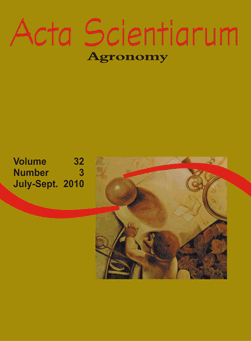<b>Mycorrhizal colonization and soil fertility under different sources and levels of nitrogen fertilization on <em>Brachiaria brizantha</em></b> - doi: 10.4025/actasciagron.v32i3.4002
Keywords:
Ajifer, ammonium sulfate, urea, pasture
Abstract
The feasibility and increase in the production of new cultivars can be obtained with the practice of nitrogen fertilization. The objective of this study was to verify the effect of sources and levels of nitrogen fertilization, concerning the depths, on the percentage of mycorrhizal colonization and soil fertility when covered by Brachiaria brizantha cv. Xaraés. A randomized blocks design was used and the treatments were under a 3 x 4 factorial scheme, regarding three nitrogen sources (urea, ammonium sulfate, and ajifer-L40) and 4 nitrogen levels (0, 100, 200 and 400 kg ha-1), studied at 2 different depths (0-0.10 and 0.10-0.20 m), with 3 replications. In each plot, the soil samples, composed of 5 simple samples, were collected, sieved, homogenized and sent for analysis. The use of ajifer and urea promoted higher production of shoot dry matter of B. brizantha cv. Xaraés. On the other hand, this dry matter showed reduction with the increase of N doses. The best fertilization dose was 100 kg ha-1 of N. The increasing doses of N employed, on the depth of 0-0.10 m, resulted in soil acidification and decreased the levels of MO, K+, Ca2+, Mg2+, SB and V%. Sporulation, but not mycorrhizal colonization, was stimulated by higher applied dosages.Downloads
Download data is not yet available.
Published
2010-08-25
How to Cite
Delbem, F. C., Scabora, M. H., Soares Filho, C. V., Heinrichs, R., Ferrari, T. A., & Cassiolato, A. M. R. (2010). <b>Mycorrhizal colonization and soil fertility under different sources and levels of nitrogen fertilization on <em>Brachiaria brizantha</em></b> - doi: 10.4025/actasciagron.v32i3.4002. Acta Scientiarum. Agronomy, 32(3), 455-461. https://doi.org/10.4025/actasciagron.v32i3.4002
Issue
Section
Crop Production
DECLARATION OF ORIGINALITY AND COPYRIGHTS
I Declare that current article is original and has not been submitted for publication, in part or in whole, to any other national or international journal.
The copyrights belong exclusively to the authors. Published content is licensed under Creative Commons Attribution 4.0 (CC BY 4.0) guidelines, which allows sharing (copy and distribution of the material in any medium or format) and adaptation (remix, transform, and build upon the material) for any purpose, even commercially, under the terms of attribution.
2.0
2019CiteScore
60th percentile
Powered by 

2.0
2019CiteScore
60th percentile
Powered by 



















































